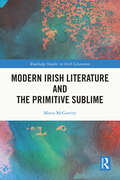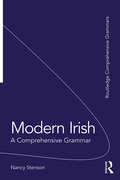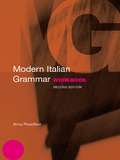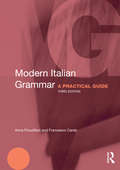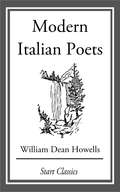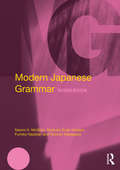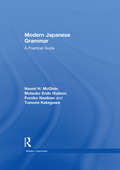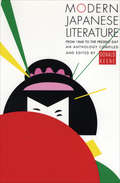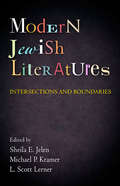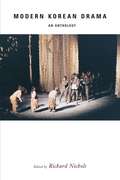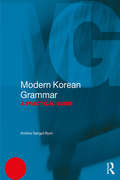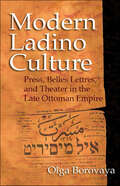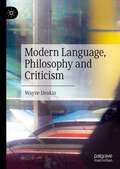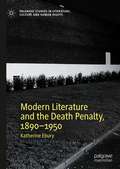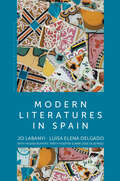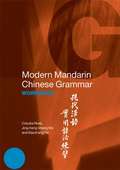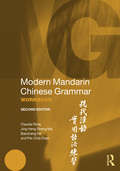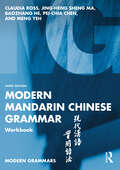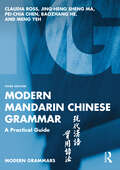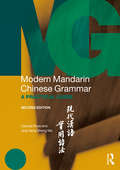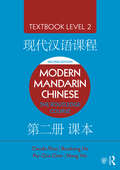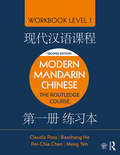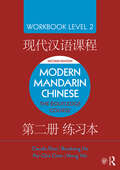- Table View
- List View
Modern Irish Literature and the Primitive Sublime (Routledge Studies in Irish Literature)
by Maria McGarrityModern Irish Literature and the Primitive Sublime reveals the primitive sublime as an overlooked aspect of modern Irish literature as central to Ireland’s artistic production and the wider global cultural production of postcolonial literature. A concern for and anxiety about the primitive persists within modern Irish culture. The “otherness” within and beyond Ireland’s borders offers writers, from the Celtic Revival through independence and partition to post-9/11, a seductive call through which to negotiate Irish identity. Ultimately, the disquieting awe of the primitive sublime is not simply a momentary recognition of Ireland’s primitive indigenous history but a repeated rhetorical gesture that beckons a transcendent elation brought about by the recognition of the troubled, ritualistic and sacrificial Irish past to reveal a fundamental aspect of the capacity to negotiate identity, viewed through another but intimately reflective of the self, within the long emerging twentieth-century Irish nation.
Modern Irish: A Comprehensive Grammar (Routledge Comprehensive Grammars)
by Nancy StensonModern Irish: A Comprehensive Grammar is a complete reference guide to modern Irish grammar, providing a thorough overview of the language. Key features include: highly systematic coverage of all levels of structure: sound system, word formation, sentence construction and connection of sentences authentic examples and English translations which provide an accessible insight into the mechanics of the language an extensive index, numbered sections, cross-references and summary charts which provide readers with easy access to the information. Modern Irish: A Comprehensive Grammar is an essential reference source for the learner and user of Irish. It is ideal for use in schools, colleges, universities, and adult classes of all types.
Modern Italian Grammar Workbook (Modern Grammar Workbooks)
by Anna ProudfootThis is an innovative book of exercises and language tasks for all learners of Italian, which can be used independently or alongside Modern Italian Grammar. Divided into three sections, this highly useful text includes: exercises based on essential grammatical structures everyday functions practice such as making introductions and expressing needs realistic role plays in short scenes, set in a range of different contexts. Implementing feedback from its predecessor, this updated second edition features exercises graded on a three-point scale according to their level of difficulty and cross-referencing to the Modern Italian Grammar for each. Also containing a comprehensive answer key for checking progress, this is a complete reference work suitable for both class-use and self-study.
Modern Italian Grammar: A Practical Guide (Modern Grammars)
by Anna Proudfoot Francesco CardoThis new edition of the Modern Italian Grammar is an innovative reference guide to Italian, combining traditional and function-based grammar in a single volume. With a strong emphasis on contemporary usage, all grammar points and functions are richly illustrated with examples. Implementing feedback from users of the first edition, this text includes clearer explanations, as well as a greater emphasis on areas of particular difficulty for learners of Italian. Divided into two sections, the book covers: traditional grammatical categories such as word order, nouns, verbs and adjectives language functions and notions such as giving and seeking information, describing processes and results, and expressing likes, dislikes and preferences. This is the ideal reference grammar for learners of Italian at all levels, from beginner to advanced. No prior knowledge of grammatical terminology is needed and a glossary of grammatical terms is provided. This Grammar is complemented by the Modern Italian Grammar Workbook Second Edition which features related exercises and activities.
Modern Italian Poets
by Jacob BlakesleyIn 1948, the poet Eugenio Montale published his Quaderno di traduzioni and created an entirely new Italian literary genre, the "translation notebook." The quaderni were the work of some of Italy's foremost poets, and their translation anthologies proved fundamental for their aesthetic and cultural development.Modern Italian Poets shows how the new genre shaped the poetic practice of the poet-translators who worked within it, including Giorgio Caproni, Giovanni Giudici, Edoardo Sanguineti, Franco Buffoni, and Nobel Prize-winner Eugenio Montale, displaying how the poet-translators used the quaderni to hone their poetic techniques, experiment with new poetic metres, and develop new theories of poetics.In addition to detailed analyses of the work of these five authors, the book covers the development of the quaderno di traduzioni and its relationship to Western theories of translation, such as those of Walter Benjamin and Benedetto Croce. In an appendix, Modern Italian Poets also provides the first complete list of all translations and quaderni di traduzioni published by more than 150 Italian poet-translators.
Modern Italian Poets: Essays and Versions
by William Dean HowellsWilliam Dean Howells (1837-1920) was an American realist author and literary critic. He wrote his first novel, Their Wedding Journey, in 1871, but his literary reputation really took off with the realist novel A Modern Instance, published in 1882, which describes the decay of a marriage. His 1885 novel The Rise of Silas Lapham is perhaps his best known, describing the rise and fall of an American entrepreneur in the paint business. His social views were also strongly reflected in the novels Annie Kilburn (1888) and A Hazard of New Fortunes (1890). While known primarily as a novelist, his short story "Editha" (1905) - included in the collection Between the Dark and the Daylight (1907) - appears in many anthologies of American literature. Howells also wrote plays, criticism, and essays about contemporary literary figures such as Ibsen, Zola, Verga, and, especially, Tolstoy, which helped establish their reputations in the United States. He also wrote critically in support of many American writers. It is perhaps in this role that he had his greatest influence.
Modern Japanese Grammar Workbook (Modern Grammar Workbooks)
by Fumiko Nazikian Naomi McGloin M. Endo Hudson Tomomi KakegawaThe Modern Japanese Grammar Workbook is an innovative book of exercises and language tasks for all learners of Japanese. The book is divided into two parts: Section A provides exercises based on essential grammatical structures Section B practises everyday functions (e.g. making introductions, apologizing, expressing needs). All sentences are written both in Romanization and in the Japanese script and a comprehensive answer key at the back enables the learner to check on their progress. Key features of the book include: Exercises graded on a 3-point scale according to their level of difficulty Cross-referencing to the related Modern Japanese Grammar Topical exercises drawn from realistic scenarios to help learners develop their vocabulary and practical communication skills Opportunities to practise both written and spoken Japanese. Modern Japanese Grammar Workbook is an ideal practice tool for learners of Japanese at all levels. No prior knowledge of grammatical terminology is assumed and it can be used both independently and alongside the Modern Japanese Grammar (ISBN 978-0-415-57201-9), which is also published by Routledge.
Modern Japanese Grammar: A Practical Guide (Modern Grammars Ser.)
by Fumiko Nazikian M. Endo HudsonFirst published in 2013. As with its series counterparts, this is an innovative reference guide to the Japanese language, combining traditional and function-based grammar in a single volume. In its two-part structure, Part A covers traditional grammatical categories, such as structural features of the language and the behaviour of parts of speech. With a strong emphasis on contemporary usage, all grammar points are richly illustrated with examples written in a combination of hiragana, katakana and kanji, alongside romanizations and sentence meanings in English.Part B is organised around language functions such as expressing likes and dislikes, giving and seeking information, making decisions and apologising. This function-based presentation is an invaluable guide to the situationally-appropriate use of Japanese for learners at all levels. The two parts of the Grammar are closely linked by extensive cross-references, providing a grammatical and a functional perspective on many patterns in the language. This is the ideal reference grammar for learners of Japanese at all levels, from novice to advanced. No prior knowledge of grammatical terminology is assumed and a glossary of grammatical terms is provided.
Modern Japanese Literature: From 1868 to the Present Day (History Of Japanese Literature Ser. #Vol. 2)
by Donald KeeneA collection of plays, essays, poetry, and reportage compiled by “the 20th-century’s premier scholar of Japanese literature” (Slate). Modern Japanese Literature is Donald Keene’s critically acclaimed companion volume to his landmark Anthology of Japanese Literature. Now considered the standard canon of modern Japanese writing translated into English, Modern Japanese Literature includes concise introductions to the writers, as well as a historical introduction by Professor Keene. Includes: “Growing Up” by Higuchi Ichiyō, a lyrical story of pre-adolescence in the nineties; Natsume Sōseki’s story of “Botchan,” an ill-starred and ineffectual Huck Finn; Nagai Kafū’s “The River Sumida;” Yokomitsu Riitchi’s Kafkaesque “Time;” Kawabata Yasunari’s “The Mole;” “The Firefly Hunt;” a glimpse into Tanizaki Junichirō’s masterpiece “Thin Snow;” and the postwar work of such writers as Dazai Osamu and Mishima Yukio.
Modern Jewish Literatures: Intersections and Boundaries (Jewish Culture and Contexts)
by Michael P. Kramer Sheila E. Jelen L. Scott LernerIs there such a thing as a distinctive Jewish literature? While definitions have been offered, none has been universally accepted. Modern Jewish literature lacks the basic markers of national literatures: it has neither a common geography nor a shared language—though works in Hebrew or Yiddish are almost certainly included—and the field is so diverse that it cannot be contained within the bounds of one literary category.Each of the fifteen essays collected in Modern Jewish Literatures takes on the above question by describing a movement across boundaries—between languages, cultures, genres, or spaces. Works in Hebrew and Yiddish are amply represented, but works in English, French, German, Italian, Ladino, and Russian are also considered. Topics range from the poetry of the Israeli nationalist Natan Alterman to the Russian poet Osip Mandelstam; from turn-of-the-century Ottoman Jewish journalism to wire-recorded Holocaust testimonies; from the intellectual salons of late eighteenth-century Berlin to the shelves of a Jewish bookstore in twentieth-century Los Angeles.The literary world described in Modern Jewish Literatures is demarcated chronologically by the Enlightenment, the Haskalah, and the French Revolution, on one end, and the fiftieth anniversary of the State of Israel on the other. The particular terms of the encounter between a Jewish past and present for modern Jews has varied greatly, by continent, country, or village, by language, and by social standing, among other things. What unites the subjects of these studies is not a common ethnic, religious, or cultural history but rather a shared endeavor to use literary production and writing in general as the laboratory in which to explore and represent Jewish experience in the modern world.
Modern Korean Drama: An Anthology
by Richard NicholsCarefully selected and represented, the plays in this collection showcase both the fantastic and the realistic innovations of Korean dramatists during a time of rapid social and historical change. Stretching from 1962 to 2004, these seven works tackle major subjects, such as the close of the Choson dynasty and the aftermath of the Korean War, while delving into trenchant cultural issues, such as the marginalization of students who rebel against mainstream education and the role of traditional values in a materialistic society. Longtime scholar of Korea and its vibrant, politically acute theater, Richard Nichols opens with a general overview of modern Korean drama since 1910 and concludes with an appendix describing theater production and audience attendance in Seoul. He chooses works that aren't just for Korean audiences. These texts confront universal themes and situations, tackling the problem of ambition, the trouble with fidelity, and the complexity of sexual and interpersonal relationships. Nichols situates each work critically, historically, and culturally, including brief biographies of playwrights and extensive notes. A bibliography also provides alternative readings and the titles of additional plays currently available in English. Primed for production, these skillful translations provide Western directors with exciting new material for the stage. At the same time, they offer students and scholars a sophisticated survey of the modern Korean dramatic tradition.
Modern Korean Grammar: A Practical Guide (Modern Grammars)
by Andrew Sangpil ByonRoutledge’s Modern Grammar series is an innovative reference guide combining traditional and function-focused grammar in a single volume, with an accompanying workbook. The aim of the Modern Korean Grammar is to provide an overview of the structures and functions of the Korean language. Designed for those who have already acquired the basics of the language, the book combines a comprehensive description of the grammatical structures of Korean with a functional/usage approach to the language. All target grammatical and functional points will be illustrated with examples in Hangul with English translations for better understanding. In addition, the use of linguistic terminology is limited, to facilitate quick and easy comprehension.
Modern Ladino Culture: Press, Belles Lettres, and Theater in the Late Ottoman Empire (Sephardi and Mizrahi Studies)
by Olga BorovayaOlga Borovaya explores the emergence and expansion of print culture in Ladino (Judeo-Spanish), the mother tongue of the Sephardic Jews of the Ottoman Empire, in the second half of the 19th and early 20th centuries. She provides the first comprehensive study of the three major forms of Ladino literary production—the press, belles lettres, and theater—as a single cultural phenomenon. The product of meticulous research and innovative methodology, Modern Ladino Culture offers a new perspective on the history of the Ladino press, a novel approach to the study of belles lettres in Ladino and their relationship to their European sources, and a fine-grained critique of Sephardic plays as venues for moral education and politicization.
Modern Language, Philosophy and Criticism
by Wayne DeakinThis books delineates the seismic shifts of the twentieth century humanities by way of a close examination of the dynamic landscape of modern language, criticism and philosophy. In this manner, it argues that both philosophy and literary criticism have dovetailed in the twenty-first century. Starting out as a survey of literary criticism in its broadest terms, later chapters - which are more expository - assess recent movements within modern literary theory. These are located with respect to the post-Russell and Fregean “linguistic turn” in philosophy. Designed for specialists and non-specialists alike; philosophers, literary critics and even students of the modern critical tradition, the argument takes a novel stance towards modern criticism, language and philosophy, arguing for a return to a more formalist and rhetorical approach to literary criticism, while taking care not to indulge too many “political pathologies” when engaging with texts.
Modern Legal Drafting
by Peter ButtIn the second edition of this highly regarded text, the authors show how and why traditional legal language has developed the peculiar characteristics that make legal documents inaccessible to the end users. Incorporating recent research and case law, the book provides a critical examination of case law and the rules of interpretation. Detailed case studies illustrate how obtuse or outdated words, phrases and concepts can be rewritten, reworked or removed altogether. Particularly useful is the step-by-step guide to drafting in the modern style, using examples from four types of common legal documents: leases, company constitutions, wills and conveyances. Readers will gain an appreciation of the historical influences on drafting practice and the use of legal terminology. They will learn about the current moves to reform legal language, and receive clear instruction on how to make their writing clearer and their legal documents more useful.
Modern Literature and the Death Penalty, 1890-1950 (Palgrave Studies in Literature, Culture and Human Rights)
by Katherine EburyThis book examines how the cultural and ethical power of literature allowed writers and readers to reflect on the practice of capital punishment in the UK, Ireland and the US between 1890 and 1950. It explores how connections between ‘high’ and ‘popular’ culture seem particularly inextricable where the death penalty is at stake, analysing a range of forms including major works of canonical literature, detective fiction, plays, polemics, criminological and psychoanalytic tracts and letters and memoirs. The book addresses conceptual understandings of the modern death penalty, including themes such as confession, the gothic, life-writing and the human-animal binary. It also discusses the role of conflict in shaping the representation of capital punishment, including chapters on the Easter Rising, on World War I, on colonial and quasi-colonial conflict and on World War II. Ebury’s overall approach aims to improve our understanding of the centrality of the death penalty and the role it played in major twentieth century literary movements and historical events.
Modern Literatures in Spain
by Jo Labanyi Luisa Elena DelgadoJo Labanyi and Luisa Elena Delgado provide the first cultural history of modern literatures in Spain. With contributors Helena Buffery, Kirsty Hooper, and Mari Jose Olaziregi, they showcase the country&’s cultural richness and complexity by working across its four major literary cultures – Castilian, Catalan, Galician, and Basque – from the eighteenth century to the present. Engaging critically with the concept of the &“national&”, Modern Literatures in Spain traces the uneven institutionalization of Spain&’s diverse literatures in a context of Castilian literary hegemony, as well as examining diasporic and exile writing . The thematically organized chapters explore literary constructions of subjectivity, gender, and sexuality; urban and rural imaginaries; intersections between high and popular culture; and the formation of a public sphere. Throughout, readings are attentive to the multiple ways in which literature serves as a barometer of cultural responses to historical change. An introduction to major cultural debates as well as an original analysis of key texts, this book is essential reading for students and scholars with an interest in the literatures and cultures of Spain.
Modern Mandarin Chinese Grammar Workbook
by Claudia Ross Baozhang He Jing-Heng Sheng MaModern Mandarin Chinese Grammar Workbook is a book of exercises and language tasks for all learners of Mandarin Chinese. Divided into two sections, the Workbook initially provides exercises based on essential grammatical structures, and moves on to practise everyday functions such as making introductions, apologizing and expressing needs. With a comprehensive answer key at the back to enable students to check on their progress, main features include: exercises graded according to level of difficulty cross-referencing to the related Modern Mandarin Chinese Grammar topical exercises that develop students' vocabulary base. Modern Mandarin Chinese Grammar Workbook is ideal for all learners of Mandarin Chinese, from beginner to intermediate and advanced students. It can be used both independently and alongside the Modern Mandarin Chinese Grammar.
Modern Mandarin Chinese Grammar Workbook (Modern Grammar Workbooks)
by Claudia Ross Baozhang He Pei-Chia Chen Jing-Heng Sheng MaModern Mandarin Chinese Grammar Workbook is a book of exercises and language tasks for all learners of Mandarin Chinese. Divided into two sections, the Workbook initially provides exercises based on essential grammatical structures, and moves on to practice everyday functions such as making introductions, apologizing and expressing needs. With an extensive answer key at the back to enable students to check on their progress, main features include: exercises at various levels of challenge for a broad range of learners cross-referencing to the related Modern Mandarin Chinese Grammar a comprehensive index to exercises alphabetically arranged in terms of structures, functions, and key Chinese structure vocabulary. This second edition also offers a revised and expanded selection of exercises including new task-based exercises. Modern Mandarin Chinese Grammar Workbook is ideal for all learners of Mandarin Chinese, from beginner to intermediate and advanced students. It can be used both independently and alongside the Modern Mandarin Chinese Grammar (978-0-415-82714-0), which is also published by Routledge.
Modern Mandarin Chinese Grammar Workbook (Modern Grammar Workbooks)
by Claudia Ross Baozhang He Pei-Chia Chen Meng Yeh Jing-Heng Sheng MaModern Mandarin Chinese Grammar Workbook, third edition, is a book of exercises and language tasks to facilitate practice and reinforce language use. Divided into two sections, the Workbook initially provides exercises based on essential grammatical structures, and moves on to practice everyday functions such as making introductions, apologizing, and expressing needs. With an extensive answer key at the back to enable students to check on their progress, main features include: Exercises at various levels of challenge for a broad range of learners Cross-referencing to the related Modern Mandarin Chinese Grammar A comprehensive index to exercises alphabetically arranged in terms of structures, functions, and key Chinese structure vocabulary This third edition also offers a revised and expanded selection of exercises including new task-based exercises. Modern Mandarin Chinese Grammar Workbook is ideal for all learners of Mandarin Chinese, from beginner to intermediate and advanced students. It can be used both independently and alongside Modern Mandarin Chinese Grammar, which is also published by Routledge.
Modern Mandarin Chinese Grammar: A Practical Guide (Modern Grammars)
by Claudia Ross Baozhang He Pei-Chia Chen Meng Yeh Jing-heng Sheng MaModern Mandarin Chinese Grammar: A Practical Guide, third edition, is an innovative reference guide to Mandarin Chinese, combining traditional and function-based grammar in a single volume. The Grammar is divided into two parts. Part A covers traditional grammar points such as phrase order, and the structure of noun phrases and verb phrases. Part B is carefully organized around language functions and situations such as: • Asking questions • Communication strategies • Making comparisons • Giving orders and making requests • Expressing apologies, regrets, and sympathy The two parts of the Grammar are closely linked by extensive cross-references, providing a grammatical and functional perspective on many patterns. The Grammar is coordinated with the Workbook, which provides grammar-focused and situation-focused exercises to facilitate practice and reinforce language use. All grammar points and functions are richly illustrated with examples presented in simplified and traditional characters and Pinyin romanization, with a strong emphasis on contemporary usage. This third edition includes new sections on character structure, social media, speaker perspective, and more, as well as updated illustrative sentences and an expanded index. Modern Mandarin Chinese Grammar is ideal for all learners of Mandarin Chinese, from beginner to intermediate and advanced students.
Modern Mandarin Chinese Grammar: A Practical Guide (Modern Grammars)
by Claudia Ross Jing-heng Sheng MaModern Mandarin Chinese Grammar provides an innovative reference guide to Mandarin Chinese, combining traditional and function-based grammar in a single volume. The Grammar is divided into two parts. Part A covers traditional grammatical categories such as phrase order, nouns, verbs and specifiers. Part B is carefully organized around language functions and notions such as: Communication strategies Making comparisons Giving and seeking information Expressing apologies, regrets and sympathies The two parts of the Grammar are closely linked by extensive cross-references, providing a grammatical and functional perspective on many patterns. All grammar points and functions are richly illustrated with examples, with a strong focus on contemporary usage. Main features of the grammar include: Examples given in simplified characters, traditional characters and romanization (pinyin) Clear explanations and accessible descriptions Particular attention to areas of particular difficulty for learners of Mandarin Chinese Implementing feedback from users of the first edition of the Grammar, this second edition has been revised throughout to offer expanded explanations, examples, cross-referencing, and indexing and brand new chapters on aspect, resultative verbs, directional verbs and "ba" sentences. This is the ideal reference grammar for learners of Mandarin Chinese at all levels, from elementary to advanced. No prior knowledge of grammatical terminology is assumed and a glossary of grammatical terms is provided. This Grammar is accompanied by the Modern Mandarin Chinese Grammar Workbook (978-0-415-83488-9; available for separate purchase) which features related exercises and activities.
Modern Mandarin Chinese: The Routledge Course Textbook Level 2
by Claudia Ross Baozhang He Pei-Chia Chen Meng YehModern Mandarin Chinese is a two-year undergraduate course for students with no prior background in Chinese study. Designed to build a strong foundation in both the spoken and written language, it develops all the basic skills such as pronunciation, character writing, word use, and structures, while placing a strong emphasis on the development of communication skills. Each level of the course consists of a textbook and workbook in simplified characters. A free companion website provides all the audio for the course with a broad range of interactive exercises and additional resources for students’ self-study, along with a comprehensive instructor’s guide with teaching tips, assessment and homework material, and a full answer key. Key changes to this new edition: This revised edition of level 2 introduces over 200 characters and over 400 new vocabulary items. Additional exercises in the workbooks and online support the expanded number of words and characters incorporated into the textbooks. New cross-references between the textbooks, workbooks, and companion website facilitate using all the resources in an integrated manner. The website has been redesigned and greatly enhanced. Retaining its focus on communicative skills and the long-term retention of characters, the text is presented in simplified characters and pinyin with a gradual and phased removal of pinyin as specific characters are introduced and learned. This approach allows students to focus on the pronunciation and meaning of new words before the corresponding characters are introduced, ensuring they are guided and supported towards reading only in characters.
Modern Mandarin Chinese: The Routledge Course Workbook Level 1 (Second Edition) (Modern Grammar Workbooks Ser.)
by Claudia Ross Baozhang He Pei-Chia Chen Meng Yeh<p>Modern Mandarin Chinese is a two-year undergraduate course for students with no prior background in Chinese study. Designed to build a strong foundation in both the spoken and written language, it develops all the basic skills such as pronunciation, character writing, word use, and structures, while placing a strong emphasis on the development of communicative skills. <p>Each level of the course consists of a textbook and workbook in simplified Chinese. A free companion website provides all the audio for the course with a broad range of interactive exercises and additional resources for students’ self-study, along with a comprehensive instructor’s guide with teaching tips, assessment and homework material, and a full answer key. <p>Key changes to this new edition: <p> <li>An increased number of vocabulary and characters introduced. 255 characters are introduced in this second edition for active production. Dialogues and example sentences are also presented in full-character format for passive recognition, and to provide additional challenge for more advanced students. <li>Additional exercises in the workbooks and online to support the expanded number of words and characters incorporated into the textbooks. <li>New cross-references between the textbooks, workbooks and companion website facilitate using all the resources in an integrated manner. <li>Greatly enhanced and re-designed website.</li> <p> <p>Retaining its focus on communicative skills and the long-term retention of characters, the text is now presented in simplified characters and pinyin from the outset with a gradual and phased removal of pinyin as specific characters are introduced and learnt. This unique approach allows students to benefit from the support of pinyin in the initial stages as they begin speaking while ensuring they are guided and supported towards reading only in characters.</p>
Modern Mandarin Chinese: The Routledge Course Workbook Level 2
by Claudia Ross Baozhang He Pei-Chia Chen Meng YehModern Mandarin Chinese is a two-year undergraduate course for students with no prior background in Chinese study. Designed to build a strong foundation in both the spoken and written language, it develops all the basic skills such as pronunciation, character writing, word use, and structures, while placing strong emphasis on the development of communicative skills. Each level of the course consists of a textbook and workbook in simplified characters. A free companion website provides all the audio for the course with a broad range of interactive exercises and additional resources for students’ self-study, along with a comprehensive instructor’s guide with teaching tips, assessment and homework material, and a full answer key. Key changes to this new edition: • This revised edition of level 2 introduces over 200 characters and over 400 new vocabulary items. • Additional exercises in the workbooks and online support the expanded number of words and characters incorporated into the textbooks. • New cross-references between the textbooks, workbooks, and companion website facilitate using all the resources in an integrated manner. • The website has been redesigned and greatly enhanced. Retaining its focus on communicative skills and the long-term retention of characters, the text is presented in simplified characters and pinyin with a gradual and phased removal of pinyin as specific characters are introduced and learned. This approach allows students to focus on the pronunciation and meaning of new words before the corresponding characters are introduced, ensuring they are guided and supported towards reading only in characters.
